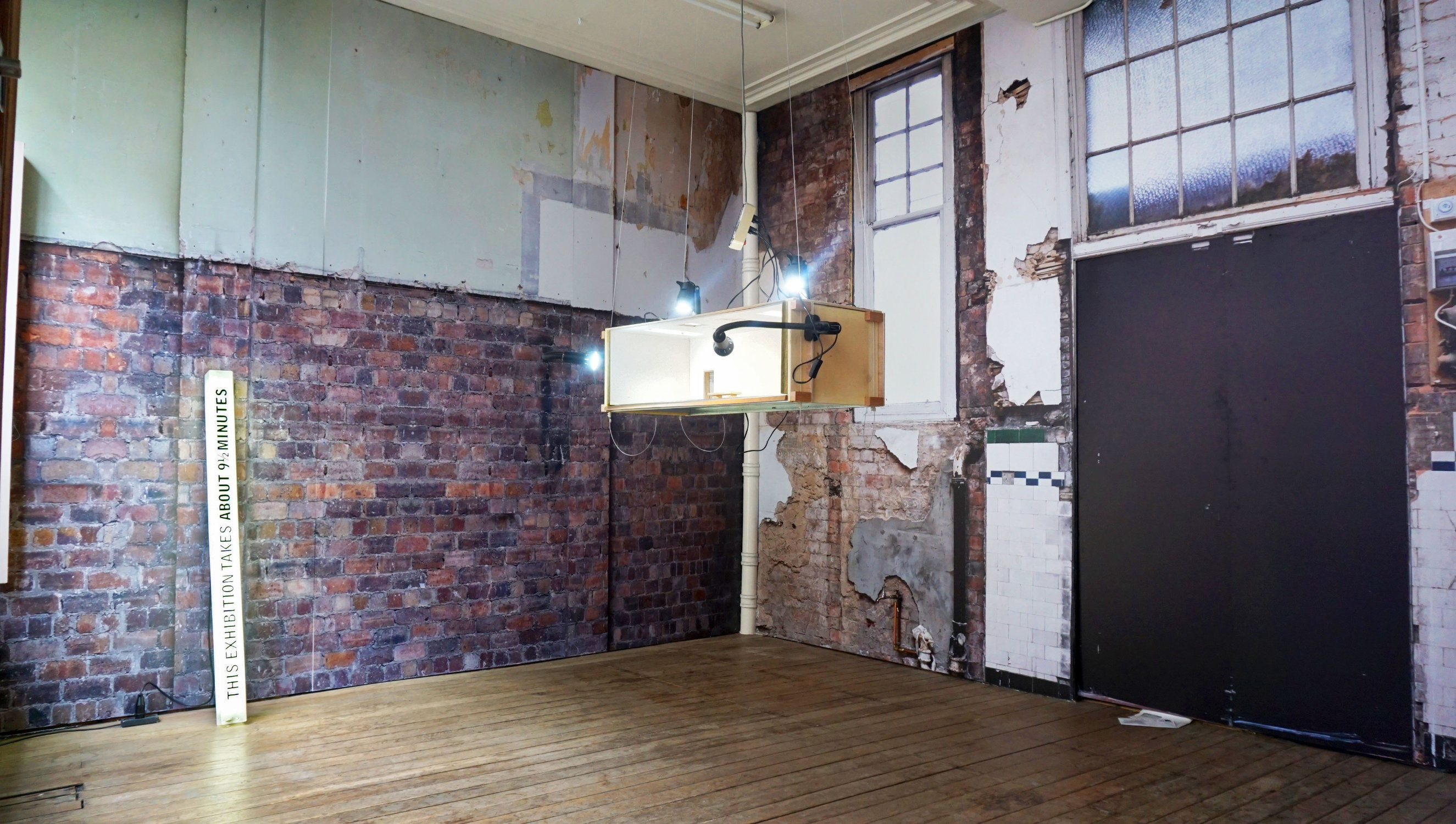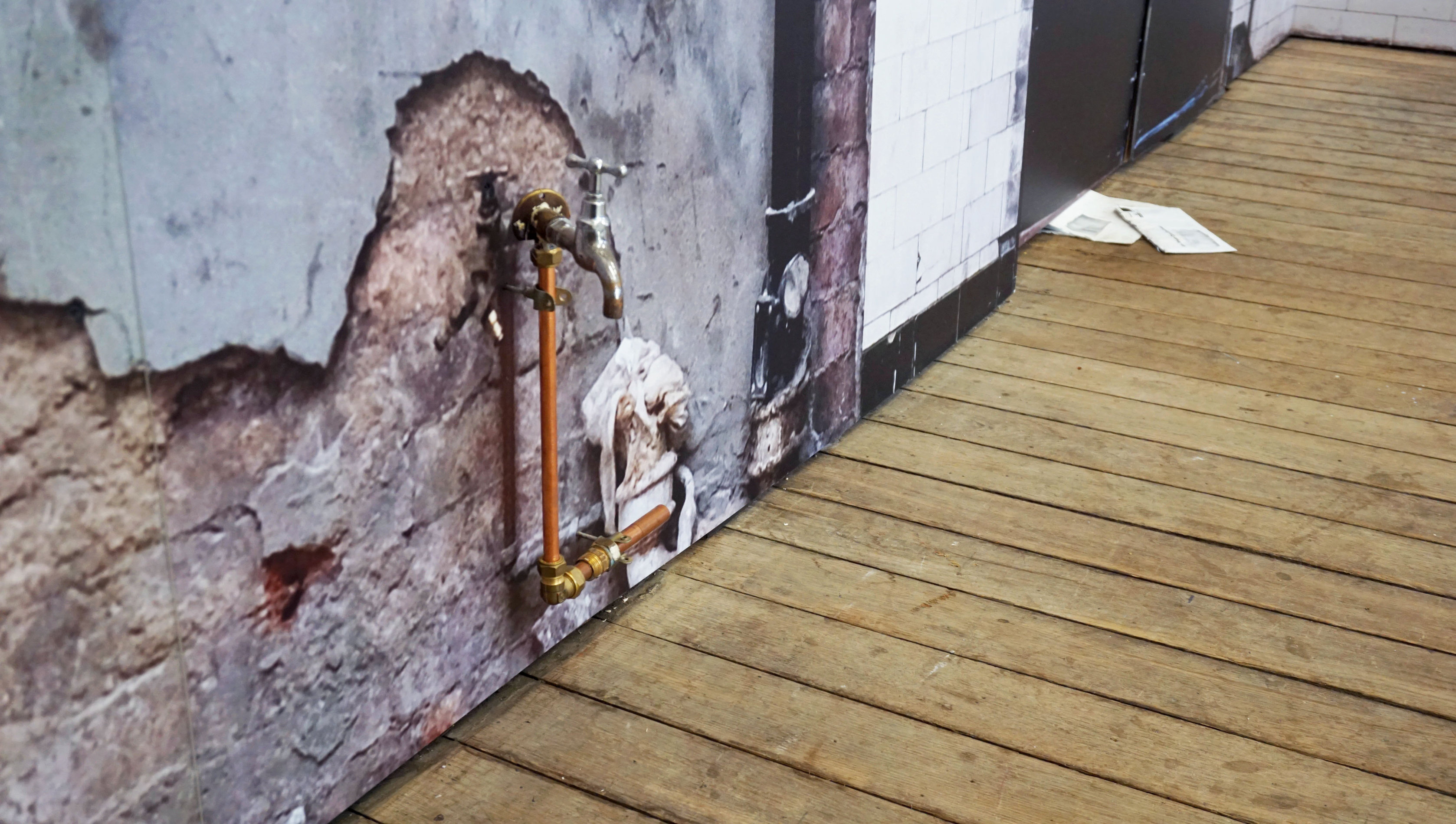Topp & Dubio Remodeling Heterotopia
The Brick Space / …ism project space, The Hague
24 May 2024 - 30 September 202420-12-2024
You’ve missed it. (Or perhaps you haven’t?) For a moment there waveringly existed a space-double, a twin-space. It unfolded on the street Westeinde, The Hague, in a space that was offered by another space. And for a moment there solidly existed a real space: a full-size copy of the Bricks Space, located on Aird’s Lane, Glasgow (part of the commercial gallery The Modern Institute, a fixture of the Glaswegian art scene for 27 years). The moment, admittedly, lasted awhile: the exhibition began expanding on the 24th of May and imploded into a vanishing point on September 30, 2024. It was named “Remodeling Heterotopia”, borrowing Foucault’s well-known term of art for the foldings of place within space, those self-shaped niches embedded like hair follicles in the tissue of the world.
To create the simulacrum the artist duo Topp & Dubio scavenged the internet for photographs of the interior of the Aird’s Lane Bricks Space. They then stretched, shortened, patched them up with grafts of brick skin and printed them life-size to cover the walls of a space they had 24/7 access to: the host, a project space under the name “… ism”, which happens to also be a sort of antechamber to Topp’s house.

During those three-and-a-half months that their heterotopia existed, it hosted a total of twenty-one exhibitions. I visited four-and-a-half of them. Each installation was a light proposition that was conceived of and realized over the week and open to visitors during the weekend. At the time I was reading a biography of the Japanese poet Matsuo Bashō, and I think the format of “Remodeling Heterotopia” can be compared to a form of linked verse known as “haikai no renga”, a type of spontaneous collaborative poetry in which each verse wittily builds on the previous one. Each curatorial iteration of the project seemed informed by (the remnants of) the preceding exhibition and showed both work by Topp & Dubio themselves as well as by guest artists.
Underneath the makeshift execution I could always discern a seemingly naïve yet comprehensive logic. The printed doors opposite the entrance are superimposed on actual doors, which lead to Topp’s living-room, rather than a roughly paved backstreet in Glasgow. Yet I could feel that space, too, behind the wall, because it exists in my mind. Every acknowledgement of the one space, mental or physical, tingles into being the existence of the other. Above the doors is a window, behind which ivy leaves are turning brown; but it is summer, and there are no leaves behind the window, because there is no window there. The two rusty nails hammered into the window frame: one changes aspect as I change position, the other remains constant, the same from every angle of the room. It’s clear Topp & Dubio had a lot of fun hiding their Easter eggs, and now and then I feel the sense of endearment you can get, seeing someone chuckle at their own joke.
Exhibition #11: “A Notion is an Idea” consists of small models of billboards that have words painted on them, words that are verbally explained on other small billboards, whose text is in turn defined on other ones. The sequence supposedly begins with the word “idea”, although arguably that word is tagged by the word “notion” in the title, which is further mentioned on one of the billboards. This referential chain reflects on a smaller scale the conceptual machinations behind the larger art project. The artists seem quite aware of the game they’re playing, referring, diverting, alluding, eluding the visitor until they lose grasp of what’s what. Dubio excitedly told me about a neighbor and faithful visitor of the Westeinde project space, who was pretty upset when he glanced through ...ism’s windows and saw a crumbling brick wall instead of the antique wooden panelling that used to line his local gallery.

The last few times I visited The Brick Space it was evening; the street was dark, light shining from the interior of the space through the two windows on either side of the entrance. Peeping through them, my gaze struck those fake brick walls. Exhibition #16 consisted of a screening: Hitchcock’s brick-rich Rear Window projected onto The Brick Space’s scenery of printed bricks. Rear Window is all about peering out from within the confines of Jimmy Stewart’s apartment at the brick walls of the neighboring buildings and the worlds that unfold behind them. If, like Stewart's telescope, The Brick Space’s street-facing windows are pointing out, then the image projected onto its retinas is that of the Aird’s Lane Bricks Space. The glassy lenses take in the Glaswegian gallery and, in a camera obscura-like twist, let it fall onto ...ism’s walls, turning upside-down both the original Bricks Space and the host-space.
Usually doubles bring with them the uncanny, but I got the impression that Topp & Dubio have managed to replace the uncanny with the funny. The play between these billboard-word-models, between The Brick Space’s multiple-spaces-in-one, operates on the same model as that of much verbal humour. Wordplay departs from one meaning to another, holding a measured gap between both. This divergence creates a space, between the expected and the substitution, in which the two incongruous meanings waveringly coexist and can converge or even become confused. It’s into this gap that the unwitting neighbor of …ism stumbled: the space not only between what is present and absent, but also between what is expected and substituted, projected and concealed. But I like it when wor(l)ds split or glide together.

In a letter to The Modern Institute published as part of the final exhibition “Vanishing Point”, Topp & Dubio say that they discovered the Aird’s Lane Bricks Space online during the Covid-19 lockdowns and “directly regarded it [as] an inaccessible space for [their] art practice”. It made me question the (in)accessibility of their own project. Because “Remodeling Heterotopia’s” conceptual play is based on its own underlying logic, and consequently requires from the visitor an approach adhering to this logic, the exhibition operates like a closed circuit. This doesn’t mean that Topp & Dubio in turn have created work that is inaccessible to the visitor. Rather, it feels like it’s somehow the opposite of inaccessible: somewhat inexitable. Minding the gap, you can easily step into the world of Topp & Dubio’s work, but stepping out, into your own interpretation of it, proves more difficult.
In “Remodeling Heterotopia” the artists set out to explore meanings and interrelations, specifically those of an exhibition, an artwork, an art space. Each subject, each suggestion is potentially repurposed by the next, consistently establishing a space in which relations shift, definitions falter and meaning is perpetually redetermined. Even the series of twenty-one exhibitions as a whole is a singular expression within a succession of iterations, articulating one possible meaning of “an exhibition” to Topp & Dubio’s practice. Tracing their artistic and curatorial choices reveals a conceptual structure that spans all levels of the project. The project is aware of examining itself as it shapes itself. The conclusion of its investigation, which it never reaches, is generated out of itself, making the project autopoietic and ultimately self-contained.